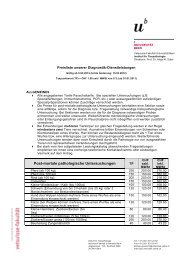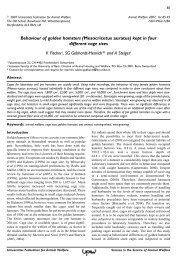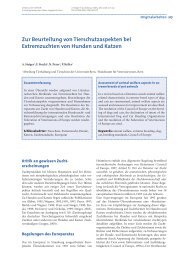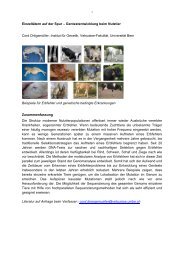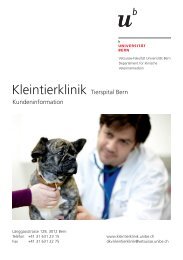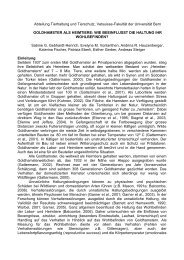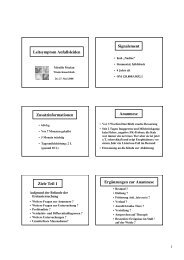Lifespan and Causes of Death in the Irish Wolfhound - Vetsuisse ...
Lifespan and Causes of Death in the Irish Wolfhound - Vetsuisse ...
Lifespan and Causes of Death in the Irish Wolfhound - Vetsuisse ...
You also want an ePaper? Increase the reach of your titles
YUMPU automatically turns print PDFs into web optimized ePapers that Google loves.
2002). On <strong>the</strong> molecular level, <strong>the</strong> form<strong>in</strong>g <strong>of</strong> cancer is a multi-step process <strong>in</strong>volv<strong>in</strong>g<br />
DNA damage (ei<strong>the</strong>r <strong>in</strong>herited or environmental), expression <strong>of</strong> growth promoters<br />
(pre-cancerous phase) <strong>and</strong> f<strong>in</strong>ally accumulation <strong>of</strong> fur<strong>the</strong>r genetic changes, lead<strong>in</strong>g to<br />
<strong>in</strong>creased malignancy (Ruttemann 2005).<br />
OS cells are poorly differentiated, mesenchymal <strong>in</strong> nature <strong>and</strong> produce osteoid, bone<br />
substance <strong>and</strong>, occasionally, cartilag<strong>in</strong>ous tissue. The tumour is characterised by an<br />
aggressive local osteolysis, periosteal reaction with <strong>the</strong> formation <strong>of</strong> new bone tissue<br />
<strong>and</strong> more or less pronounced s<strong>of</strong>t tissue swell<strong>in</strong>g. Micro-metastases occur early <strong>in</strong><br />
<strong>the</strong> course <strong>of</strong> <strong>the</strong> disease; <strong>the</strong> most common sites be<strong>in</strong>g <strong>the</strong> lungs <strong>and</strong> o<strong>the</strong>r bones.<br />
Over 90% <strong>of</strong> affected <strong>in</strong>dividuals may have microscopic lung metastases at <strong>the</strong> time<br />
<strong>of</strong> diagnosis (Chun <strong>and</strong> Morrison 2004). Osteolysis can eventually lead to<br />
pathological fractures <strong>of</strong> <strong>the</strong> affected bone (Suter <strong>and</strong> Niem<strong>and</strong> 2001 b).<br />
3.4.1.2 Symptoms<br />
OS can rema<strong>in</strong> without symptoms for some time <strong>and</strong> <strong>the</strong>n gradually or suddenly<br />
cause various degrees <strong>of</strong> lameness, <strong>the</strong> development <strong>of</strong> which can be comb<strong>in</strong>ed with<br />
an actual or perceived <strong>in</strong>jury to <strong>the</strong> limb <strong>in</strong> question. Symptoms <strong>of</strong> manifest OS<br />
<strong>in</strong>clude lameness <strong>and</strong> strong pa<strong>in</strong> upon palpation. A swell<strong>in</strong>g is not obligatory <strong>and</strong><br />
usually only easily discernable where <strong>the</strong> bone is not covered by muscle (Suter <strong>and</strong><br />
Niem<strong>and</strong> 2001 b). The most frequent locations are reported to be “distant from <strong>the</strong><br />
elbow, close to <strong>the</strong> knee” (Chun <strong>and</strong> Morrison 2004).<br />
3.4.1.3 Diagnosis<br />
Every metaphysical swell<strong>in</strong>g <strong>in</strong> middle-aged large dogs should be considered<br />
potentially tumorous until <strong>the</strong> assumption is disproved (Suter <strong>and</strong> Niem<strong>and</strong> 2001 b).<br />
Radiographic signs <strong>in</strong>clude a comb<strong>in</strong>ation <strong>of</strong> bone lysis <strong>and</strong> proliferation, which can<br />
lead to <strong>the</strong> characteristic “sunburst” pattern (Kramer, Latimer et al. 2003). As<br />
opposed to benign changes (osteomyelitis), <strong>the</strong>re is no sclerotic demarcation l<strong>in</strong>e<br />
between <strong>the</strong> lesion <strong>and</strong> healthy bone tissue. Marked s<strong>of</strong>t tissue swell<strong>in</strong>g is also<br />
common (Suter <strong>and</strong> Niem<strong>and</strong> 2001 b; Chun <strong>and</strong> Morrison 2004).<br />
Pulmonary metastases are <strong>of</strong>ten <strong>in</strong>visible at <strong>the</strong> time <strong>of</strong> diagnosis, but as stated<br />
above, it is very probable that micro-metastases are already present <strong>in</strong> dogs with<br />
manifest cl<strong>in</strong>ical signs <strong>of</strong> OS despite this. Never<strong>the</strong>less, thoracic radiographs (3<br />
views) should always been taken when OS is suspected (Chun <strong>and</strong> Morrison 2004).<br />
It is also possible, although unusual, to additionally do CT or sc<strong>in</strong>tigraphic bone<br />
scans to diagnose OS. CT is more sensitive at detect<strong>in</strong>g early bone lysis, while<br />
sc<strong>in</strong>tigraphy may be useful for identify<strong>in</strong>g metastatic disease at an earlier stage than<br />
X-rays. The latter procedure will not dist<strong>in</strong>guish between sites <strong>of</strong> previous trauma or<br />
<strong>in</strong>flammation <strong>and</strong> metastases though (Chun <strong>and</strong> Morrison 2004).<br />
Laboratory f<strong>in</strong>d<strong>in</strong>gs are absent or non-specific, but it seems that an <strong>in</strong>creased AP<br />
level is associated with a poorer prognosis (Chun <strong>and</strong> Morrison 2004).<br />
The gold st<strong>and</strong>ard for diagnosis is a tumour biopsy. Given that different tumour types<br />
react differently to different <strong>the</strong>rapy protocols <strong>and</strong> have vary<strong>in</strong>g prognoses, it should<br />
be considered if a specific <strong>the</strong>rapy is planned. Multiple core biopsies us<strong>in</strong>g a<br />
25




